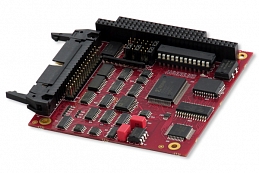| Thermocouple Measurement | |
|---|---|
| This application note covers the practical fundamentals of thermocouple theory and discusses Sensoray's approach to thermocouple measurement. |

|
IntroductionThermocouples are one of the most commonly used type of temperature sensor. They are popular in measurement and control applications because of their relatively low cost and wide temperature measurement ranges. In particular, thermocouples excel at measuring high temperatures where most other types of sensors cannot function. These advantages, however, are offset by the unwieldy physics of thermocouples — physics that can present formidable technical challenges to their practical use. Thermocouple structureA thermocouple consists of two electrical conductors that are made of different metal alloys. Typically, the two conductors are built into a cable that has a heat-resistant outer sheath. In some cases an additional conductive shield may be present that surrounds the two inner conductors. At one end of the cable, the two conductors are mechanically and electrically connected together by crimping, welding or other means. This end of the thermocouple (known as the hot junction) is placed at the location that is to be measured. The other end of the thermocouple (the cold junction, or reference junction) is connected to a thermocouple measurement system. It should be noted that "hot" junction can be somewhat of a misnomer, as this junction will be subjected to a temperature below that of the reference junction if relatively cold temperatures are being measured. Reference junction compensationThermocouples generate an open-circuit voltage (resulting from the Seebeck effect) that is proportional to the temperature difference between the hot and reference junctions: Vs = V(Thot - Tref) Since thermocouple voltage is a function of the temperature difference between junctions, it is necessary to know both the voltage and temperature at the cold junction in order to determine the hot junction's temperature. Consequently, a thermocouple measurement system must either measure the reference junction temperature or control it so as to maintain it at a stable, known temperature. Most industrial thermocouple measurement systems measure, rather than control, the reference junction temperature. Sensoray's Smart Sensor Interfaces measure thermocouple reference junction temperature with a dedicated analog input channel. Dedicating a special channel to this function is beneficial in several ways. For example, no application channels are consumed by the reference junction sensor, so all channels remain available for measuring external sensors. Also, the channel is automatically configured, acquired, and processed by the Smart Sensor Interface so that the host need not be involved nor concerned with reference junction compensation. The dedicated channel is designed to directly connect to the reference junction sensor found on many Sensoray termination boards (e.g., model 7409TC). LinearizationThe relationship between thermocouple voltage and temperature is proportional but not linear. In fact, thermocouples are quite nonlinear over their operating temperature ranges. In order to obtain temperature from a thermocouple, it is necessary to convert the thermocouple voltage to temperature units. This process, which is called linearization, typically encompasses nonlinear voltage-to-temperature conversion as well as conversion to the desired temperature units. Several methods are commonly used to linearize thermocouples. The simplest method is to perform no actual linearization at all but instead restrict the thermocouple's operating range to limit the magnitude of its nonlinearity, though this is practical only if a narrow range of temperatures will be measured. At the other extreme, special thermocouple interface components (integrated circuits or modules) are available that perform linearization in the analog domain. This may be practical if one or two thermocouples are being measured, but costs can quickly spiral out of control for higher thermocouple counts, making this technique unsuitable for many larger, multipoint data acquisition systems. It's also possible to perform linearization in the digital domain with arithmetic functions or lookup tables. Sensoray's Smart Sensor Interfaces take a hybrid digital approach that uses tables of cubic spline approximations to implement fast yet highly accurate linearization across the full thermocouple temperature measurement range. Temperature measurement processSensoray's Smart Sensor Interfaces employ thermocouple measurement and linearization methods that hold down costs without sacrificing performance and they perform these functions autonomously so that system integrators can focus on the application instead of the details of thermocouple interfacing. 
Sensoray's Model 518 Smart Sensor Interface supports First, the onboard processor digitizes the thermocouple and reference junction sensor signals to obtain thermocouple voltage Vt and reference junction temperature Tref. The reference junction is digitized less frequently that the thermocouple signal because it's temperature changes more slowly. To maximize throughput, reference junction measurements are transparently and automatically interleaved between thermocouple measurements, and sensor data acquisition is overlapped with post-processing of the previous acquisition. The Smart Sensor Interface then performs linearization and reference junction compensation in the digital domain. Depending on the thermocouple type being used, an appropriate correction voltage is computed by mapping reference junction temperature into equivalent thermocouple voltage: Vc = V(Tref). This correction voltage is added to the measured thermocouple voltage to obtain the corrected thermocouple voltage: Vtc = Vt + Vc. Finally, the corrected thermocouple voltage is linearized and converted to temperature units: T = T(Vtc). SummarySensoray's Smart Sensor Interfaces are designed to speed system development and take the grunt work out of thermocouple interfacing. Today's developers are under ever-increasing pressure to produce results quickly, and freeing system developers from thermocouple interfacing complexities is a great way to relieve that pressure. Our Smart Sensor Interfaces do just that — they take care of thermocouple measurement so developers can focus on the big picture. |
|

